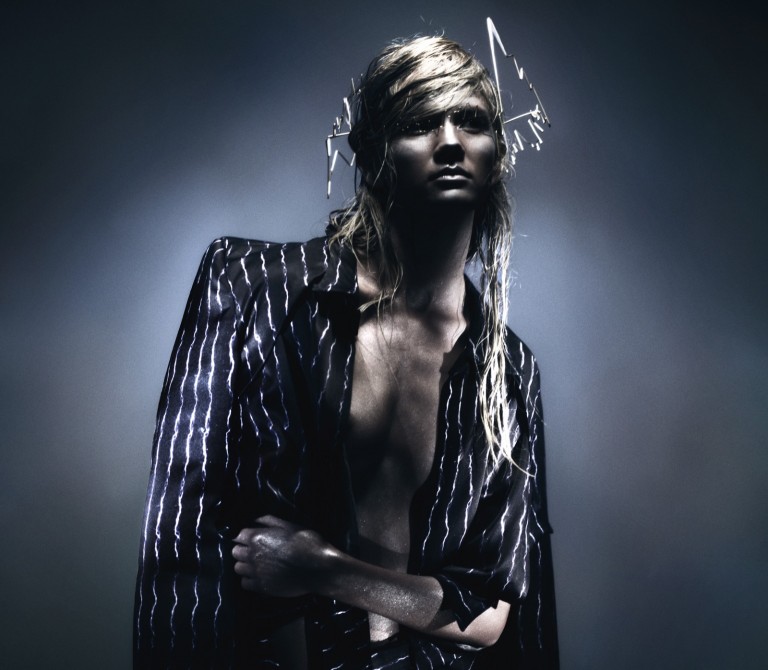Each season with many emerging and established designers calling for attention, fashion week, and indeed the fashion industry, is as arresting as it is unforgiving. From season to season, young designers live and die by the sartorial sword, flourishing or falling, some at the first graduation hurdle. And yet, there is that rare exception that captures the imagination from the outset, leaving an indelible mark, leaving you wanting more, knowing you’ll get it because they are that good. Yoav Hadari is one such talent. Even from this non-binary designer’s inaugural collection in 2022, entitled ‘DE-STILLED’, we saw a shining ability. Yoav, at such an embryonic stage in their design career, demonstrated a masterful approach to tailoring and drapery, creating garments with boundary-pushing aesthetics.
This season Yoav has launched their latest collection, Cerebral Body, under their new label HADARI previewing it alongside a groundbreaking film shot and directed by globally renowned filmmaker Ruth Hogben with shots from photographer Thomas Alexander. The film was made with the help of Birmingham University, taking inspiration from artists like Erwin Blumenfeld and MC Escher and the thoughts and feelings expressed as an outsider, while Thomas’s photographs, an interpretation of medical imagery, are hauntingly beautiful.
Hadari presented the screening at London’s highly prestigious Sarabande Foundation. Founded in 2006 by late designer Lee Alexander McQueen, Sarabande is an incubator for exceptional talent. It is a community of artists of all disciplines, providing mentorship from fashion’s highest-ranking ‘ambassadors’ like Iris Van Herpen to Sean Leane and Nick Knight.
It was the work of McQueen that first drew Yoav to the world of fashion. Born in Palestine and a keen gamer, they told us previously, “That’s when it dawned on me finally that fashion isn’t only a child of colonial and consumerist values but can also be an art form and a way to challenge society.” From there, Hadari explored their ideas at Shenkar College in Israel before working for industry icons Thom Browne and Daniel Roseberry. With an impressive C.V. to date, Yoav drew on their high-profile tutelage to explore sustainable solutions to manufacturing while developing new processes and aesthetics.
This season, through their experience as a neurodivergent designer and their father’s struggle with Lewy body dementia, Yoav delved into the world of neuroscience, EEG’s and AI, considering how this facet of science could inform their latest collection. Using elements like MRI prints of deep blues against infinite dark, the result is yet another exceptional collection. The designer is also acutely aware of the climate crisis, creating garments entirely from repurposed materials and deadstock and utilising sustainable embroidery techniques that demonstrate expert craftsmanship with consideration for the environment.
We sat down with Yoav to ask about their latest collection, the collaborative work that accompanies Cerebral Body, and their future goals and aspirations.
Congratulations on another beautiful collection under your new label HADARI. Your collection is a translation of your experience as a neurodivergent designer; how do you think your neurodiversity informs your design process, and have you found it has brought benefits to the way you work and develop concepts?
Thank you! For me, this collection is really about the power of the cerebral.
Generally, where I notice my neurodivergence most is around social matters. It means that communication isn’t always easy for me, and it makes it easy for me to want to escape to my work, where it’s easier for me to communicate myself and my emotions; this means that most of my energy goes toward the creative world I work to create, the clothes and the story behind them.
Iris Van Herpen nominated you to receive a scholarship at the prestigious Sarabande Foundation, started by Lee MacQueen in 2006. As a designer in residence at the Sarabande, what lessons have you learned so far and who has inspired you most and why?
I learned a lot at Sarabande. The one big thing I can already say that I am taking away with me is to be focused, know exactly what my goals are for my work and then make a course of action that facilitates a path that leads there. Generally, it’s a lot of the business side and a lot of mentorship that we receive from Sarabande around those matters. Matters they don’t even mention in design school that are actually a big part of what it means to run your own label every day, like logistics, taxes, pricing and more.
The world of neuroscience and neurodiversity was part of your research for this collection, looking at brain scans and heightened spiritual awareness states. Aside from the concept of regeneration and MRI prints, what other key elements did you take from this study to inform and inspire this collection?
The colours and materials were all inspired by neuroscience; the first two groups of the collection are all in shades of blue, white and deep navy inspired by the imagery of MRI of Lewy body disease patients and various x-ray. I love examining the corporeal through the ethereal, using lightweight materials like tulle, organza and shirting, all recycled, donated or dead stock. In the third group, we also had our Face print created with AI-generated faces and manipulated by AI. I was fascinated with the idea of using machine thinking to create artwork and seeing how a machine consciousness interprets human concepts.
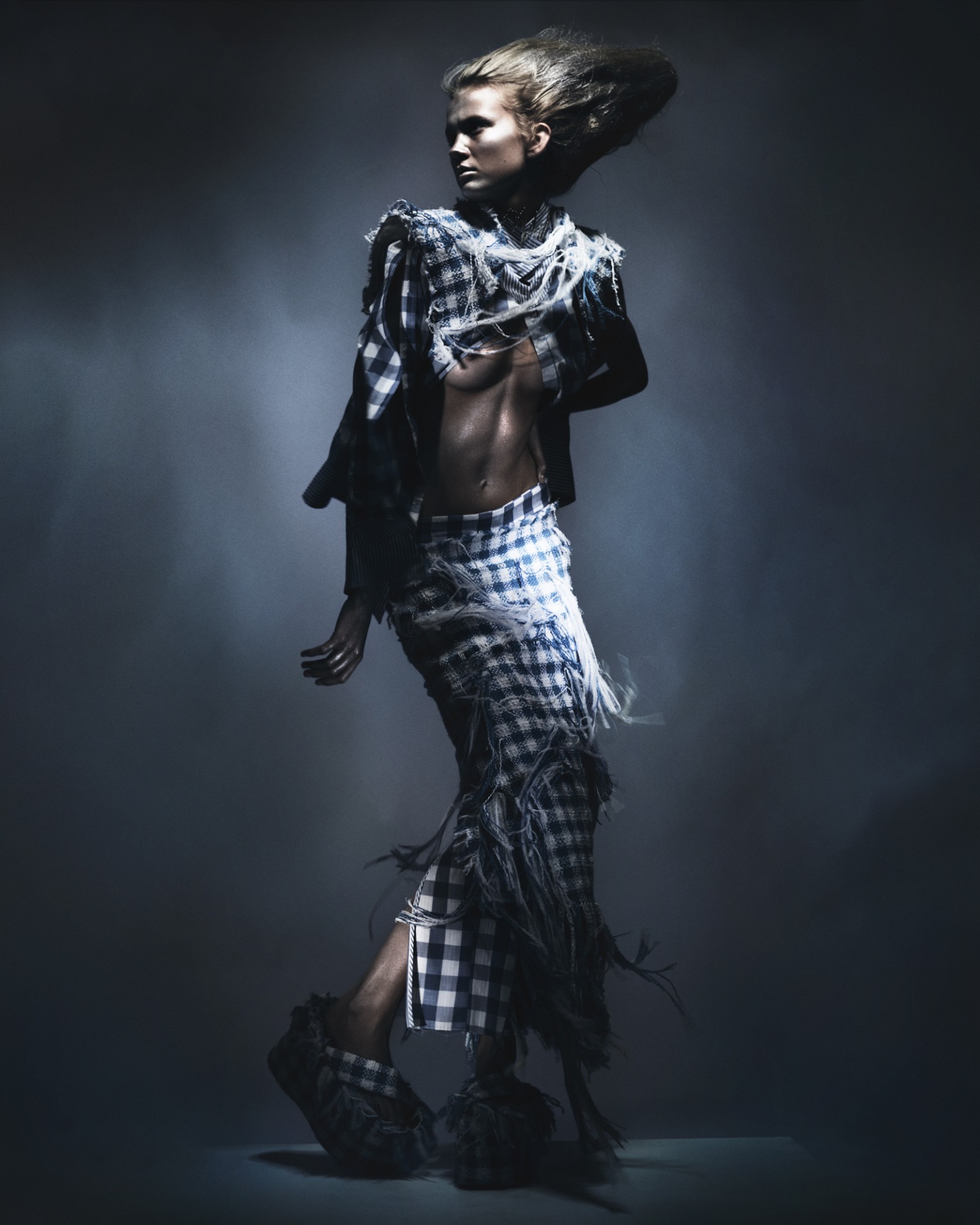

The collection features sustainable types of embroidery such as ‘book page’ and slicing’ for this collection. Can you elaborate on these techniques?
This was one way we recycled fabrics this season, cutting up donated or deadstock fabrics to create new embroidered surfaces. The book page technique works with squares stitched in even intervals to create a 3D texture that looks like the side of a book if you look at it closed. The slicing technique is similar, but instead of squares I work with strips of fabric and stitch them flat. I love 3-dimensional surfaces. My goal with these developments was to find a new way to upcycle that feels like something other than patchwork or collage and that feels integral to the design approach.
You use deadstock fabric throughout the collection supplied by Alexander McQueen, LCF and CSM stores, and other stores in the UK. Is this a practice you will continue for future collections, and what advice would you give young designers about sourcing these materials?
Yes, that is definitely the way forward for my brand. One thing I know is that there are kilos upon kilos of fabric rolls in the world lying in storage and collecting dust. Brands pay money to store them and see no profit, I think the smart brands are now turning around to resell or donate.
My advice to young designers like me would be not to be afraid to ask! People do like to donate, and many good people care not only about young designers who need cheap and quality material but also about the state of our world.
With many designers claiming to use sustainable practices and large global firms using greenwashing tactics, what other changes would you like to see from the industry to help the environmental cause?
The industry would start embracing making less. It’s hard when you’re a global business, and you want to make a lot of money, but it’s actually that mindset that is problematic to our world in a sustainable lens.
In my grandparents’ day, it was common to own only a certain amount of clothes and amend them with need.
Making is pollution, even if you are the most sustainable, you can be.
Small brands like mine can get away with it, my orders are small, and the pieces are uniquely crafted and made in circular ways, so my waste is minimal, and I don’t activate a lot of carbon emission in my process.
The bigger brands should find a way to make it attractive for their clients to keep the older season pieces, some already accept returns for recycling, but there is still untapped potential in that direction. A decade ago, television made the jump from channels to streaming. Why can’t fashion find a solution like that? I’d love a Balenciaga subscription that gives me access to certain price point pieces for a certain monthly amount, for example.
The fashion business is still too old-fashioned, and it’s ironic as we love thinking of ourselves as the future.


You worked with Sarabande alumna Conor Joseph to create EEG brainwave jewellery and milliner Lottie Fenby to produce accessories to accompany the collection; what was it about these designers’ work that you felt worked for this collection?
Lottie is a dear friend and she used to work for Stephen Jones and now works making hats for television. She is not only super talented, but she has been there for me in good and bad times and helped me finish my MA collection as well.
I met Connor at a Sarabande last year when I briefly shared a studio there for a few months during the lockdown. I love his work because it always deals with the Body, in his case, the skin.
How does your heritage inform your designs, from processes to aesthetics and other elements and what prompted you to incorporate the Armenian ceramic prints featured in the collection?
My heritage plays a big part in the work I do. My grandfather was a prominent figure behind the scenes in the early days of Israel in the 1940s and 50s, including some scientific endeavours that are classified nowadays. He went to study nuclear physics when he was 40 and became a notable scientist in Israel. Science was always in my DNA, and although I never developed an affinity for it because I’m horrible with numbers, it definitely comes into my world and inspiration. The Armenian ceramics that influenced some of the colours this season comes from Jerusalem, where I grew up, and references a collection my mom found over the years of blue-white Armenian ceramics that we had at home.
Having taught internationally in various academies, what advice would you like to share with other neurodivergent designers that could help them with their creative journey?
To be fully honest, I am still coping with my own neurodivergent identity and sometimes find it hard to classify which parts of me come from there and which parts are just personality. What I can say is that you can’t fight your own nature. Stop justifying. Don’t do what you think you should do because it has more justification behind it, as it is more common or accepted – just do what comes naturally to you.
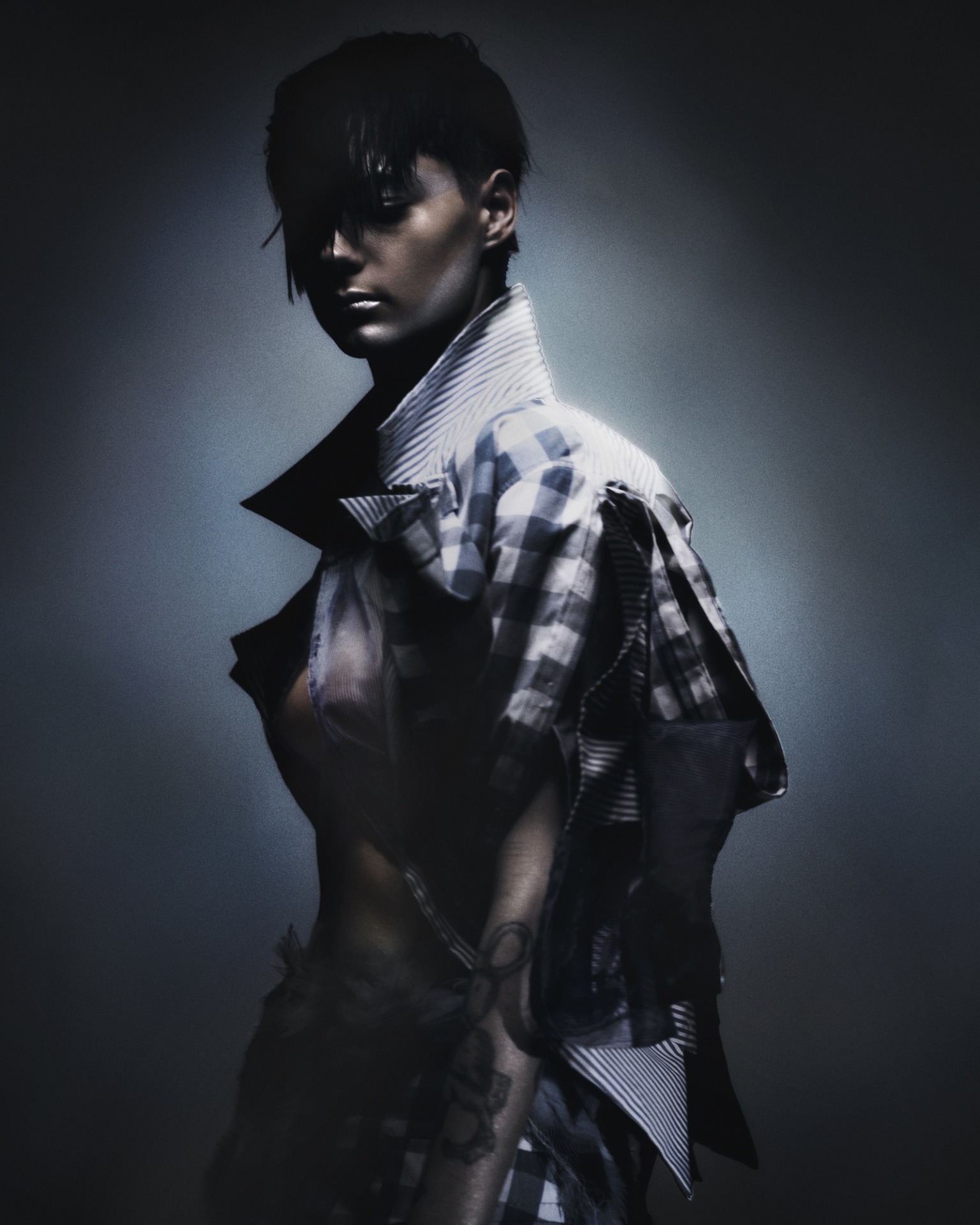
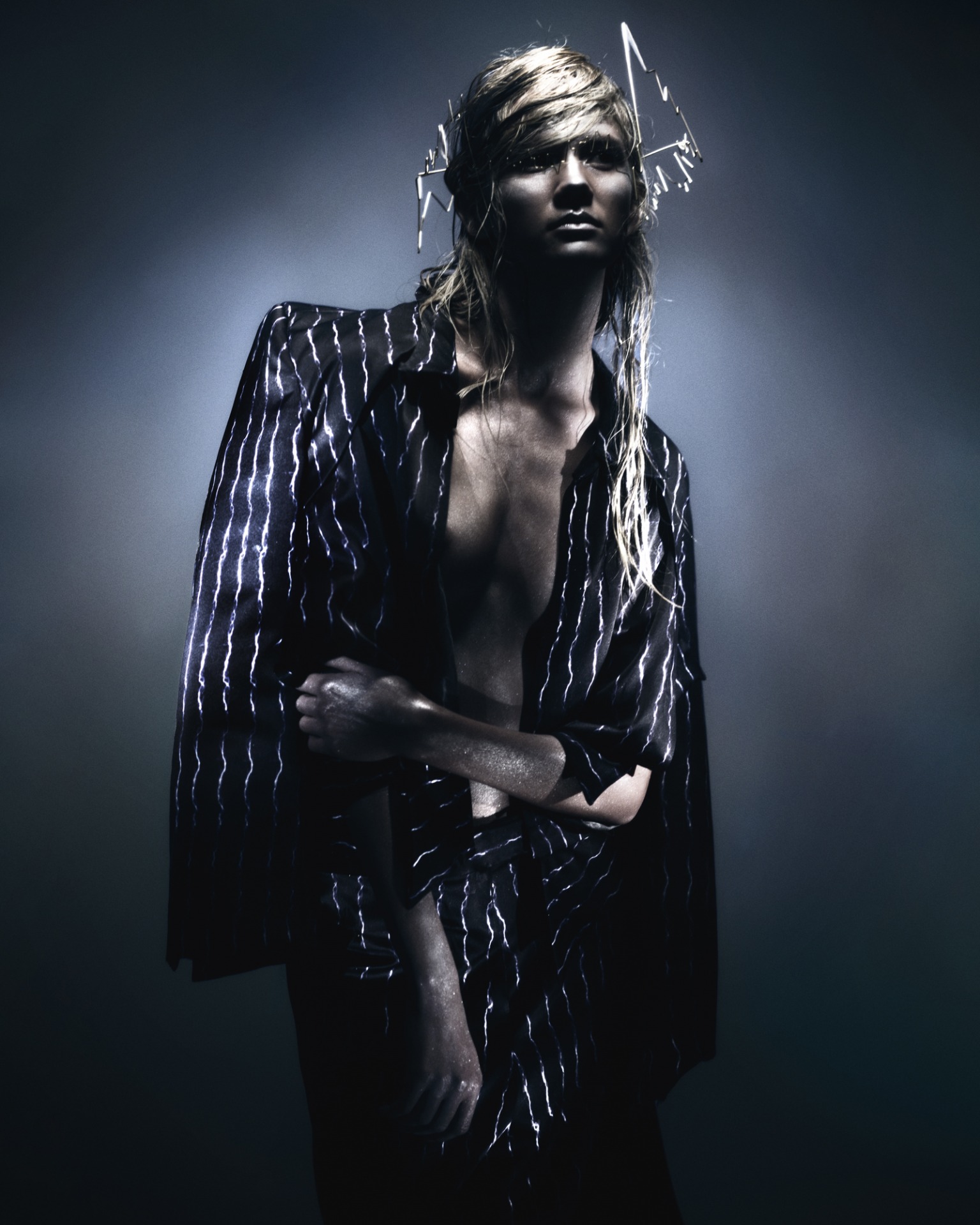
The stunning film for this collection resulted from your collaboration with filmmaker/director Ruth Hogben. How did you find the experience, and how important for you is film as a medium for translating the message behind this collection?
The experience of making this film was a beautiful experience, and it taught me so much about producing anything! I am so thankful for all the people who came together to help both of us in the process, and I met some good friends along the way, including Ruth. Working with Ruth felt easy; it was as if she was in my head at every turn and could reference things I’ve drawn, looked at or designed that I hadn’t even shown her prior to it.
To me, film is an important medium to tell stories and engage with people. We are multi-sensory beings, and the more of our senses involved in an experience – the better; this was my first collection, and it was important for me to tell the story in a way that people can engage with.
The collection is documented in a series of visually striking images by Photographer Thomas Alexander, how did you develop the look of this shoot? What was the thought process?
This collaboration with Thomas was one of my favourites. He is so talented, and we connected immediately. We developed it together, looking at my development boards and talking about the MRI and x-ray imagery that inspired the collection. It was important for me to create a mood, and I wanted to have a feeling of an identity emerging from the darkness, just like how a brain scan just appears, but many times they are with holes and imperfect, so we mirrored that in lighting and styling.
What are your hopes and aspirations for the future of HADARI?
I see HADARI as a creative brand that inspires new thinking and shows the beauty in subjects that we sometimes find hard to confront and easy to overlook. I see HADARI as part of a new fashion industry that prioritises community, the health of our world, its people, and its designers.
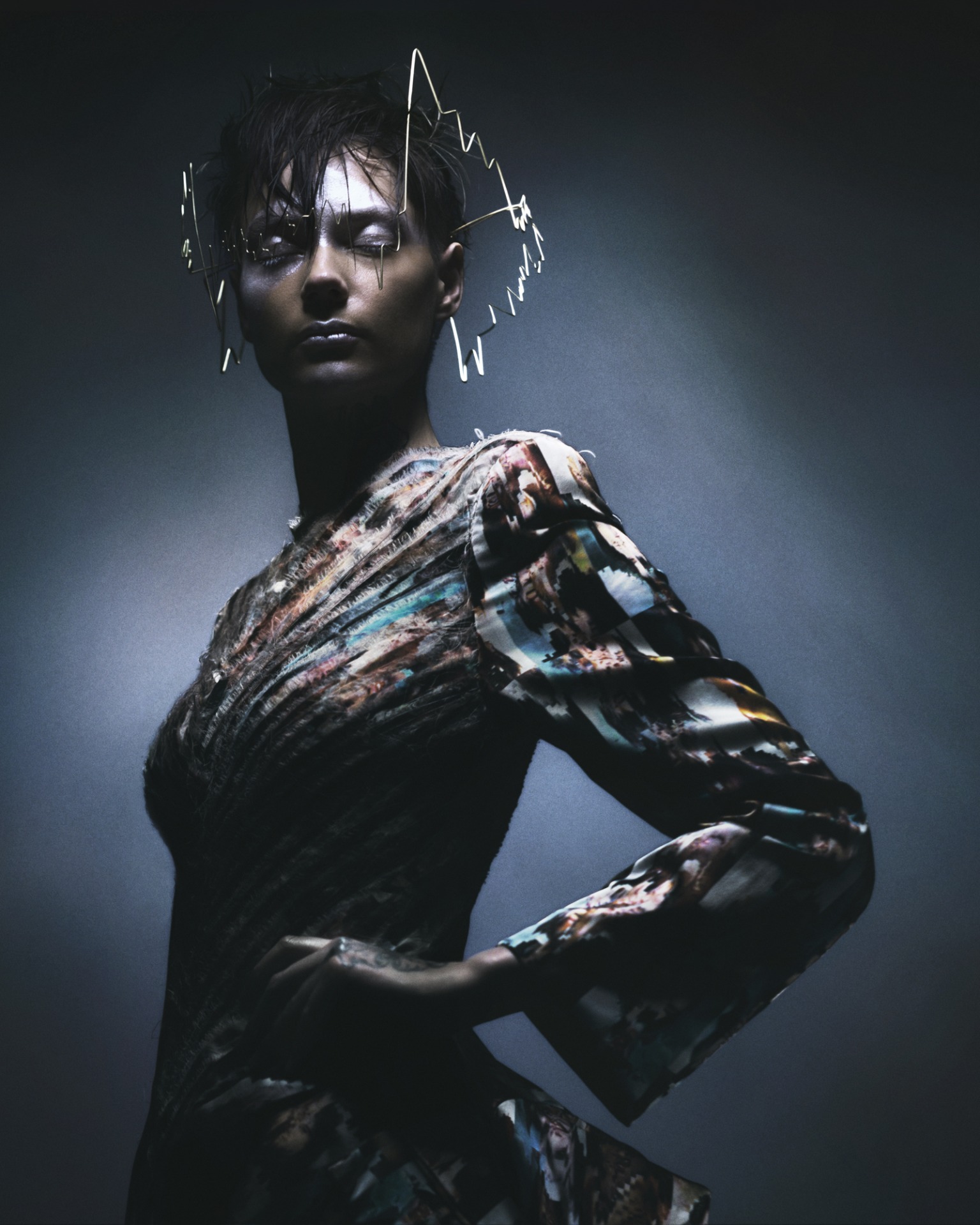
Yoav Hadari is part of an industry that, whilst it embraces much of the experimental, boundary-pushing mindsets of its collective creatives, is also a world that takes immense dedication and exceptional vision to succeed. Navigating this as non-binary with the social challenges of neurodiversity and a family heartache may be too much for some. Still, Yoav reflects on and embraces their world and channels it into their creativity to produce works that express an exceptional breadth of talent.
Drawing on those profoundly personal elements of their life, Yoav has created a stunning collection that is just as thought-provoking and accomplished as the garments in their graduate show. It illustrates a designer with not only exceptional talent but with a dedication to their craft. Yoav produces garments that stand out aesthetically, with a deep understanding of the difference skilled craftsmanship and dedication make. It is a stunning yet wearable collection with a conscience, art produced with ethics, drawing from their heritage and the strength demonstrated by their father in his most challenging days.
Cerebral Body is the work of a designer that understands the interconnectedness of us all through their insightful take on sustainable design to their collaborations with other exceptional creatives that share their vision. Undoubtedly, they deserve their place at the Sarabande, along with contemporaries like Paolo Carzana; they are shedding the stereotypes and carving a path for the possibilities of sustainable design.
It’s heartening to see that repurposed materials can result in garments with stunning contemporary aesthetics. It signals a tide of change, and who better to do it than the new creatives like Yoav, who are carrying forth Lee’s unwavering vision and message? Let fashion be meaningful; let fashion be art, show that true fashion is original, thought-provoking, and not fast; it arises through talent, collaboration and dedication, and above all, make sure it changes perceptions for the better. With Cerebral Bodies, Yoav has demonstrated all of the above, and for that, Lee would surely be proud.
Follow Yoav Hadari on Instagram
Words: Brian James and Leigh Maynard
Campaign Credits:
Photography: Thomas Alexander
Designer: HADARI
Design Assistants: Marwinda Bespoke and Evita Vitolina
Casting director: Aymeric at AYMCASTING
Modeling: Wilhelmina Dalborg
Makeup: Joey Choy
Hair: Declan Sheils
Jewellery: Conor Joseph
Head Pieces: Lottie Fenby
Retouching: Joseph Colley at Passeridea
Video Credits:
Director: Ruth Hogben
Designer: HADARI
Casting Director Miro Raynov
Modeling: Harry_Browse, Mia Yang, Dami
Design Assistants: Marwinda Bespoke and Zein Karam
Makeup: Yoi Wan
Hair: Chad Taber
Jewellery: Conor Joseph
Head Pieces: Lottie Fenby
3D Sequences: Josephine Miller and Ash
Sound Design and Track: Felipe FS Narvaez and Marcos Gerez
Lighting Designer: Robin Brigham
Line Producer: Emily Green
Directors Assistant: Danielle Adams
D.P: Arron Sheekey
Media Tech: David M
Camera Op: Shah Mahiuddin
Runners: Beth Carroll, Pauliina Katarina Leskinen, Harrison Kentish, Clare Fay, Nikki Serra
University: Joe Miles at Birmingham City University
